New Multi-State Dental Partnership Organization (DPO) Launches with 27 Practice Locations
Rising Tide Dental Partners has launched a new DPO, Rising Tide, to promote exceptional patient care and sustainable business growth while ensuring...
The dental industry is quickly evolving. Our exclusive 2025 Dental Trends Outlook reveals what to expect in the coming year, backed by real data and expert insights with actionable steps to help you succeed.

The dental industry has faced a roller coaster of changes since 2020, and this year was no different. Economic and political uncertainty challenged organizations, with inflation leading to higher costs and impacting patients’ willingness to spend. Staffing remained a major challenge, with dental assistants and hygienists being the hardest to hire and retain.
We continue to see a lot of growth, with many dental professionals reevaluating how they run their practices to meet market demands. And with patient demand for a consumer-focused experience reaching an all-time high, practices are turning to technology – from online booking to clinical AI detection tools.
It’s also been great to see the growing awareness of how oral health impacts overall health, leading to an increased demand for preventive care and higher production.
As we look to 2025, I feel optimistic. It’s clear dental technology is advancing faster than ever, which means we have the innovation, motivation, and, quite frankly, the duty, to streamline operations, reduce costs, and elevate patient experiences.
Our team at Henry Schein One delved into the insights of industry experts, including leaders from major DSOs, nimble private practices, and agile tech startups to get a true lay of the land on what to expect rolling into 2025. The time is now to hone in on better attraction, acceptance, and business for our counterparts across the dental landscape.
“The dental industry lags behind in adopting technology to streamline patient care and financial processes. By leveraging innovation, providers can alleviate administrative burdens, optimize revenue cycles, and prioritize patient well-being.” — Christine King, CEO, Henry Schein One
![]()
 We’re starting with the first steps of the patient journey — getting them in the chair. There is an expectation to provide a consumer-driven experience. A trip to the dentist must be as convenient as visiting a favorite restaurant.
We’re starting with the first steps of the patient journey — getting them in the chair. There is an expectation to provide a consumer-driven experience. A trip to the dentist must be as convenient as visiting a favorite restaurant.
“We’ve seen enormous breakthroughs in how we communicate with patients, but we have to make the entire process easier for dental practices,” said King.
 The pressure is on to create a welcoming environment patients want to return to. In 2025, we’ll see enormous growth of AI tools facilitating a better patient experience, including online booking and automated appointment reminders.
The pressure is on to create a welcoming environment patients want to return to. In 2025, we’ll see enormous growth of AI tools facilitating a better patient experience, including online booking and automated appointment reminders.
“AI will be crucial in both clinical and patient-facing aspects of dentistry. It can assist with clinical tasks, while also streamlining patient scheduling, billing, treatment plan review, and after-hours support,” said Adam McDaniel, Director and GM of Clinical Solutions, Henry Schein One.
Patients frequently decline recommended dental treatments due to concerns about cost, fear, or a perceived lack of urgency. This results in a significant treatment gap, with only 25%-30% of necessary procedures being completed.3 Dentists aren’t recommending unnecessary treatment, so where’s the disconnect?
Continued adoption of clinical AI will help increase case acceptance numbers, and data backs that up: 77% of surveyed dentists observed positive practice outcomes using AI,5 and 59% of surveyed patients are more likely to accept treatment recommendations backed by AI.6
We’re looking beyond the patient experience to the factors affecting business operations and growth. In 2025, that starts with addressing the continued staffing crisis.
Vacant positions in dental assisting and dental hygiene have reduced dental practice capacity by an estimated 10% nationally.7
Transformation in the dental industry will take time, but early adopters of AI and automation will gain a competitive edge by improving margins and offering competitive rates.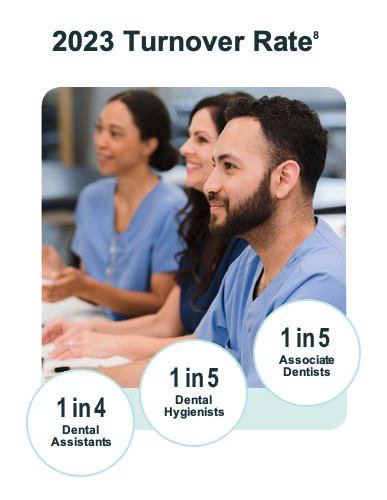
“Practices should be using technology to their benefit. Reminders at the right time, convenient booking, and flexible payment options — this creates an experience that makes patients want to stay, it’s what keeps them returning.”
— Ali Hyatt, Chief Customer and Growth Officer, Henry Schein One
Automated technology will grow in popularity
Automated tools – like online booking and patient reminders – will only grow in popularity. Patients are less likely to choose a practice that requires them to call during work hours or deal with paper forms and bills. Plus, it reduces the administrative burden on your team.
“I think that’s a big thing that practices are trying to figure out,” said Kyle Surrat, Chief Business Officer, The Jetty Group. “How do we automate as much as we can and how do we create a seamless communication flow across multiple communication platforms to create that great patient experience?”
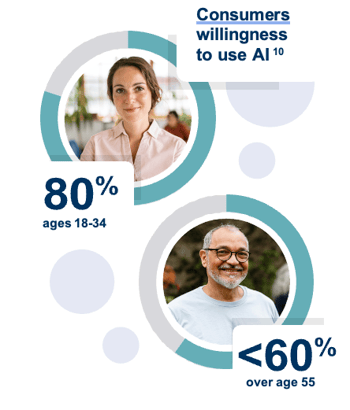
“I think patients value human interaction and human experience, but they value convenience more,” said Adam McDaniel, Director and GM of Clinical Solutions, Henry Schein One. “Where convenience overrules the human experience is where AI will help.”
We’ll see the most growth in online booking. One survey showed that 95% of respondents have – or would – book an appointment online if offered.11
“The practices that have AI in their offices are going to be more successful,” said Tamara Whitley, Owner and Office Director, Whitley Family Dental. “Patients don’t want to text us or call for an appointment anymore. Online booking is going to blow up.”
 Reviews will drive how patients find practices
Reviews will drive how patients find practices
Most patients turn to reviews and referrals when looking for a practice. People want to hear from their peers and others in the community.
We see a growing trend to encourage positive word-of-mouth and online reviews. As consumer behavior evolves, we’ll need to monitor emerging platforms beyond Google, including social media and healthcare review sites.
Patients still expect a human touch
While automation is on the rise, human connection and a seamless experience are essential to prevent patients from choosing competitors.
Small touches, like knowing patients’ preferred names and personal details, can significantly enhance loyalty, which is critical considering the low patient retention rate of around 50%.13
“Be real – authenticity will always win with patients,” said Hyatt. “Make sure you celebrate the people in your office and your patients. Consider celebrating milestones like the anniversary of when a patient got their braces off. More than anything, patients want to feel like they’re seen and heard.”
Community outreach and support will continue trending. “The reality is if you’re a dental office, and you’re sponsoring the local sports team or such, that’s really key to establishing your reputation,” said Hyatt. We’re seeing a major shift underway as younger, tech-savvy dentists join practices, taking over from retiring generations. Newer dentists face the challenge of attracting new patients while maintaining the expectations of long-term clients and their families.
We’re seeing a major shift underway as younger, tech-savvy dentists join practices, taking over from retiring generations. Newer dentists face the challenge of attracting new patients while maintaining the expectations of long-term clients and their families.
“Today’s informed patients are actively researching their healthcare options. The question is: do we want them to collaborate with us while they’re there in the office or do we want them to look for a second opinion once
they leave? I think practices are smart enough to realize the opportunity to educate is when the patient is in the chair.”
— Adam McDaniel, Director and GM of Clinical Solutions, Henry Schein One
When we think about acceptance, we need to think about pricing transparency and patient education.
 Patients want to understand their coverage
Patients want to understand their coverage
This will be one of the first years we see price transparency across most of the industry.
“A patient’s ability to afford treatment plays a big role in why they accept the recommendation. Doctors want to provide price transparency when the patient is chairside,” said Martin Kearns, GM, Revenue Cycle Management, Henry Schein One. “We’ll see significant demand for clinical tools that can be adapted into tools for sales, patient-facing education, and marketing.”
Patients want to understand the treatment plan, what insurance covers, and the available payment options. With pricing transparency, we’re going to see higher acceptance rates. “Approximately 1 in 5 of our customers anticipate needing major dental work in 2025. Alongside this, there is a strong demand for greater cost transparency upfront, enabling patients to make more informed decisions,” said Chris Butler, CEO, DentalPlans.com. “Consumers will continue to understand and evaluate options that make the treatments they need more affordable.”
“Approximately 1 in 5 of our customers anticipate needing major dental work in 2025. Alongside this, there is a strong demand for greater cost transparency upfront, enabling patients to make more informed decisions,” said Chris Butler, CEO, DentalPlans.com. “Consumers will continue to understand and evaluate options that make the treatments they need more affordable.”
Clinical AI will drive patient acceptance rates
Early adopters already use AI for patient education. Clinical AI will grow as mindsets shift from, “AI is forcing me to change as a practitioner” to “AI enables me to be a better practitioner.”
“In 2025 we’ll be on the cusp of mass AI adoption.
A significant portion of dental offices have already incorporated AI into their workflows,” said Florian Hillen, CEO, VideaHealth. “We’re already seeing patients confirm that offices have AI before their appointments.”
 In fact, a study done by VideaHealth found that across 470,831 patients and 100 locations, the average dental practice saw a 13% rise in annual net production for restorative and periodontal treatments, representing an annual growth of $78,268 per practice.16
In fact, a study done by VideaHealth found that across 470,831 patients and 100 locations, the average dental practice saw a 13% rise in annual net production for restorative and periodontal treatments, representing an annual growth of $78,268 per practice.16
“Patients trust healthcare more when it’s backed with AI, but they won’t trust AI on its own,” said McDaniel. “Do they want an office that’s using technology to help create a better experience, though? Overwhelmingly yes.”
Patients want to be more involved in their oral health
The average case acceptance rate is 46%18 — we’ve got some work to do here. When patients go to the dentist for a problem, 44% of respondents19 said they’ve declined or delayed a treatment.
In 2025, transparency will help practices to engage patients more deeply, transforming the conversation to improve oral health outcomes and treatment acceptance.
“Patients want to be more involved in conversations about their health. They want to know where their money is going,” said Whitley. “That’s going to be huge in the next year because patients are hungry for education now.”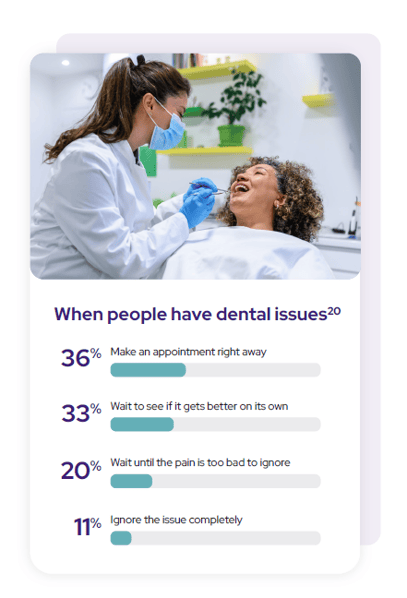
“In the next year, we’re going to see a renewed interest in data and reporting, doubling down on security, and aggressive cost-saving measures, due to capital constraints and high interest rates.”
— Alan Rencher, Chief Technology Officer, Henry Schein One
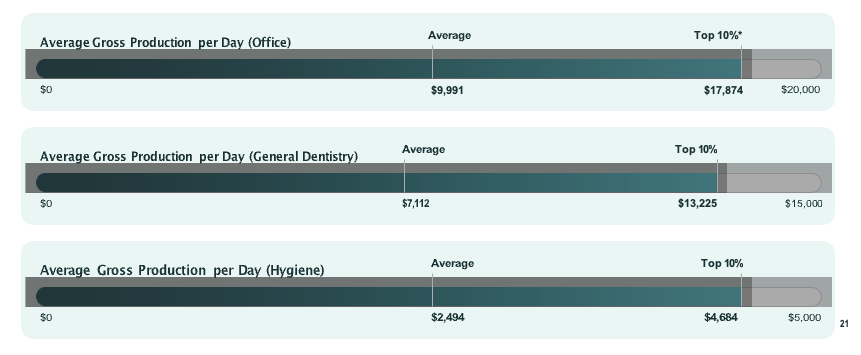
Analytics reporting will become a market standard
The future of dentistry is data driven. Doctors will increasingly adopt analytics to gain deeper insights into their practice performance. By integrating analytics into existing systems, they can measure the impact of strategic decisions and optimize resource allocation.
“Dentists are very entrepreneurial minded, but oftentimes not very business minded. We’re now seeing this acknowledgment of, ‘We need an expert or tools that help us get access to this data,’” said Surrat. “Technology investments will be huge there. There’s a critical need to measure the ROI of marketing investments and optimize spending to drive patient acquisition.”
Practices overall want more predictive analytics to help them fill the schedule and increase case acceptance. They’re thinking about how intelligent technology can help with this behind-the-scenes.
“Our industry’s changed, and it’s harder to be a successful private practice owner. With reimbursement rates as low as they are, with expenses as high as they’ve been, practices have no choice but to monitor the numbers,”
said Erin Silva, Practice Administrator, Chesterfield Family Dentistry. “Most dentists have never been taught how to run a business. And if they do have a native business acumen, they need tools to guide them financially and operationally to grow their practice.”
It’s time for a revenue cycle management renaissance
The future of revenue cycle management (RCM) lies in automation. As technology advances, practices will be able to automate more tasks, leading to increased efficiency, reduced errors, and improved financial outcomes.
“Dental insurance faces two main challenges heading into 2025: stagnant reimbursement rates and the administrative burden of claims processing,” said Butler. “Reimbursement rates have largely stalled despite rising operational costs. This puts pressure on dental practices to absorb the cost or pass them onto patients, making essential treatments less affordable.”
We’ll see three key areas where automation will simplify RCM in 2025:
1. Pre-appointment automated eligibility checks.
We’ll see an increased demand for eligibility checks built directly into workflows. This pre-appointment automation will save staff time

2. Cleaner claims for less returns.
On average, 8% of dental claims are denied from total procedures billed.23 More practices will choose technology that helps prevent mistakes. Payors will also continue, if not accelerate, the adoption of AI over the next 12-18 months to offset operating expenses. Eventually, we’ll see AI not just reviewing the claim and radiograph, but ultimately pre-approving or pre-adjudicating the claim.
“First-time claim acceptance is becoming more of a table stakes need for offices and that’s only going to accelerate,” said Kearns. “Offices will demand that their software intuitively knows which fields need to be filled out and when a field is filled out incorrectly.”
3. Adoption of electronic payments.
More practices will adopt electronic fund transfers (EFT) in 2025 to help offset operating costs. When a check is electronically wired into their account, they have the comfort of knowing that it was auto-reconciled first against the claim amount and matches the ledger.
“We’re seeing the most technological growth around getting paid and revenue cycle management because they’re the biggest pain points for offices. The current time investment isn’t financially viable,” said King.

Cyberattacks will increase, but so will security
“It’s no longer a matter of ‘if the industry is attacked again,’ but when will it happen, who it will affect, and how painful will the fallout be,” said Rencher.
With an expected increase in cyberattacks, we’re going to see an uptick in practices and vendors who invest in protecting their data.
“Credible companies have a responsibility to protect your patient and practice data,” said Rencher. “You shouldn’t have to think about whether your practice management system (PMS) is secure. By leveraging cloud-based solutions, you benefit from robust security measures, including advanced threat protection, secure coding practices, and expert monitoring, all managed by your vendor’s security team.”
We may also see some new regulations come down the pipeline. There are drafts currently in Congress, and we’re likely going to see changes in regulatory compliance and new laws in 2025.
Digital transformation will continue to accelerate
Cloud-based PMS platforms have come a long way over the past few years, making it easier to standardize, centralize, and train teams. To maintain operational efficiency and provide consistent support, DSOs are moving away from a decentralized approach and towards standardized platform solutions.
“When it comes to PMS platforms, we’re going to see a greater adoption of standards where there’s been resistance previously,” said Surrat. “People are getting more comfortable with cloud-based platforms and applications and are moving toward that standardization camp. So now it’s a question of ‘how do we make that really easy for them to adopt and standardize across all of their locations?’”
There’s also a generational reality that younger dentists prefer the cloud. The cloud-based segment is expected to grow at the fastest rate, driven by continuous technological advancements and increasing adoption.24
If you’re not looking ahead, you’re falling behind,” said Kwane Watson, CEO, Kare Mobile. “We would definitely suggest or expect that anyone who wants to be a leader in the future of dentistry would look at that cost as an investment in their future.”
Cloud providers handle critical security updates, system patches, and backups automatically, eliminating the need for on-site support to stay up on the latest threats and required updates. For a dentist whose primary expertise is in patient care, cloud solutions can provide security and reliability with less hands-on management.
By mitigating risks from cyberattacks and natural disasters, cloud-based solutions help protect critical patient data and help businesses stay up and running.
“From a disaster recovery perspective, it’s easier to manage these things within a data center versus having a bunch of disparate servers all over the place,” said Aaron Reymann-Row, Director of IT, 42 North Dental.
 Staffing will continue to be one of the biggest challenges
Staffing will continue to be one of the biggest challenges
Every single expert we spoke to agreed: staffing will continue to be a major challenge, and whether we see improvement in the next year will depend a great deal on the economy.
Most challenging has been dental hygienists and assistants. We’ve seen a number of hygienists leave the profession, but hygiene programs haven’t necessarily increased their acceptance rates. Because of this, dental assistant and hygienist poaching will continue in 2025.
"Shortages are continuing to happen, and enrollment in hygienist programs is not going up,” said Whitley. “Just paying your hygienist more per hour is not going to stop them from job hopping. You’re going to have to do more, and for a lot of practices, more can’t be on the salary line. “From an academic standpoint, the demand for oral healthcare is flying through the roof, yet our schools aren’t miraculously growing,” said Rick Gay, General Manager, Academic, Henry Schein One. “They can’t take more people.”
“From an academic standpoint, the demand for oral healthcare is flying through the roof, yet our schools aren’t miraculously growing,” said Rick Gay, General Manager, Academic, Henry Schein One. “They can’t take more people.”
To combat the shortage, we’ve seen major DSOs start dental hygiene and assistant schools and focus more on work culture and career advancement planning. Multiple pieces of legislation have also been introduced, aiming to increase the pipeline of dental providers, especially in underserved areas.
This is the year we fully embrace automation
In the past, to not lose their margins, practices would hire more people. That can’t be the case anymore. Clinical costs have skyrocketed so much that the margin must be made up somewhere else. The only way to do that is to help staff become twice as effective with automated technology.
“I believe we’re on the precipice of an influx of AI enabled tools that are going to push productivity to a new level,” said McDaniel. “We’ll also see today’s tools and software adapt to include AI capabilities.”
Additionally, we’ve heard from so many practice managers that they would never take a job with a practice that doesn’t use automated patient relationship management tools, and that will only grow in 2025.
“We ought to be able to reduce the need for staff, and, at the moment, staff are required to have quite high skill levels,” said Brian Weatherly, Chief Operating and Strategy Officer, Henry Schein One. “We should be able to help ease that and reduce the time to it takes to train somebody.”
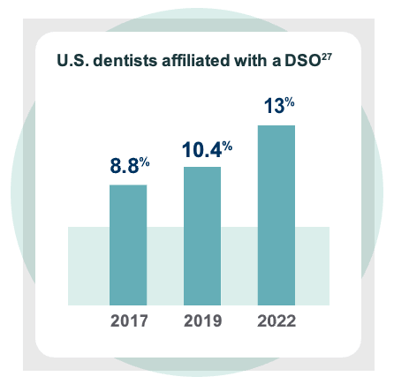
Growth is inevitable – despite challenges
“We’re seeing lower patient foot traffic and spend. Everybody is affected by the environment,” said Weatherly. “If interest rates ease a bit, mortgage prices come down, or if there are other drivers of consumer confidence, that might ease things a little bit."
If interest rates continue to go down, it’ll trigger a buying moment for DSOs. We’ll likely see them start to purchase more locations, with a lot of competitive deals coming down to who can give the doctor the highest multiple and best path to retirement and immediate savings.
“How do you drive good business in light of personnel challenges? I think you’re going to see practices continue to find ways to work smarter to remain lean and efficient to drive more revenue per appointment,” said Surrat.
We’ll also witness a rise in new dentists navigating toward DSOs. “Younger dentists want the benefits of owning a practice, but they don’t want to have to do the work associated when they can join a DSO,” said Whitley. “Is there always going to be a need for private practice? Absolutely. But do new grads want to own their own practice? They don’t.”
Practices will look to AI to meet growth goals
The hygienist shortage may take decades to resolve based on graduation and retirement numbers, but dentists still have to fill chairs. To meet the needs of their patients and existing team members, they’re turning towards technology.
“The biggest challenge we’ll see with AI is education. We have thousands of early adopters, but to get there, we’ve done a lot of work educating clinicians about the opportunities and limitations of AI,” said Hillen. “We need to continuously provide that same level of education.”
We’ve heard the same thing from dentists across the industry in the past few years: “I don’t need AI. I know how to diagnose.” But we’re seeing that conversation start to shift, with clinicians realizing that the larger benefit of AI is patient education and trust.
“I think as you have staffing shortages, there are two big benefits to clinical AI: It will make your practice and team more productive and help newer graduates gain confidence and learn quicker,” said Hillen. “AI also helps increase organic office growth. Of the patients coming into the office chair, AI helps convert more treatment, leading to higher revenue.”
In 2025, smarter, not harder means leveraging the tools and insights that elevate patient care, trust, and business efficiency. From convenience at every touchpoint and financial transparency to advanced diagnostics and streamlined operations, this year’s trends offer a clear guide on staying ahead and delivering an extraordinary experience.
1 Henry Schein One Industry Report; Henry Schein One
2 High Tech Takeover; Dental Products Report
3 The ‘Golden Age’ of Dentistry; Becker’s Dental + DSO Review
4 AI Would Make More People Trust Their Dentist More, New Survey Shows; Forbes
5 More than One Third of Dentists Use AI in Practice, Study Says; Dentistry
6 Six in 10 Patients More Likely to Trust Their Dentist If They Use AI, Survey Says; Dentistry
7 Dental Workforce Shortage: Data to Navigate Today’s Labor Market; ADA
8 2024 Dental Salary Survey Report; DentalPost
9 Economic Outlook and Emerging Issues in Dentistry; Health Policy Institute, American Dental Association
10 PwC’s 2024 US Healthcare Consumer Insights and Engagement Survey; PWC
11 Online Appointment Scheduling: A Missed Chance to Boost Patient Satisfaction; Physicians Practice
12 Local Consumer Review Survey 2023: Customer Reviews and Behavior (brightlocal.com)
13 Henry Schein One Industry Report; Henry Schein One
14 PwC’s 2024 US Healthcare Consumer Insights and Engagement Survey; PwC
15 Trends in Healthcare Payments Annual Report; J.P. Morgan
16 Dental AI: Hype or Reality – The True Impact on Dentistry; VideaHealth
17 AI Would Make People Trust Their Dentist More, New Survey Shows; Forbes
18 Henry Schein One Industry Report; Henry Schein One
19 AI Would Make People Trust Their Dentist More, New Survey Shows; Forbes
20 AI Would Make People Trust Their Dentist More, New Survey Shows; Forbes
21 Henry Schein One Industry Report; Henry Schein One, based on data in Jarvis Analytics.
*The top 10% of dental practices from our collected data
22 Based on survey of 15 Eligibility Pro beta customers and interviews with four Eligibility Pro beta customers completed by Henry Schein One in July and August 2024; average hours spent across the entire team at a practice
23 A Time for Disruption; ADG; survey limited to a large dental insurance company only
24 U.S. Dental Practice Management Software Market Size, Share & Trends Analysis Report; Grand View Research
25 HPI Examines Dentist Workload Impact from Staffing Shortages; ADA News
26 The State of Dentistry – Economic and Demographic Trends Impacting the Industry in 2024; ADSO
27 Practice Modality by the Numbers; new dentist news
Rising Tide Dental Partners has launched a new DPO, Rising Tide, to promote exceptional patient care and sustainable business growth while ensuring...
Heartland Dental has launched a new brand campaign, Masters and Mentors, to convey its doctor-led culture and support model. The ongoing series is...
Patrick Perodin, COO of Marquee Dental Partners, describes his experiences in different DSO and dental consulting roles and how he developed his “ops...